2. 中国冶金地质总局第二地质勘查院, 福州 350108;
3. 同位素地球化学国家重点实验室, 中国科学院广州地球化学研究所, 广州 510640;
4. 中国科学院大学, 北京 100049
2. The Second Geological Institute of China Metallurgical Geology Bureau, Fuzhou 350108, China;
3. State Key Laboratory of Isotope Geochemistry, Guangzhou Institute of Geochemistry, Chinese Academy of Sciences, Guangzhou 510640, China;
4. University of the Chinese Academy of Sciences, Beijing 100049, China
华南位于欧亚大陆的东南缘,是由多个块体或地体拼合增生而成的大陆板块,主要构造单元包括扬子地块、江南造山带、华夏地块等。华南经历了多期构造运动,发育了多期次构造-岩浆活动,其中以中生代的构造-岩浆活动最为强烈,整体出露大约220, 000km2的火山岩和侵入岩(Zhou et al., 2006; Wang et al., 2011; Li et al., 2012a; Sun et al., 2012),其中大部分是燕山早期(中晚侏罗世)花岗岩(图 1a),与稀有金属矿产(W-Sn-Nb-Ta)有非常密切的关系,是中国花岗岩与成矿作用研究的摇篮。
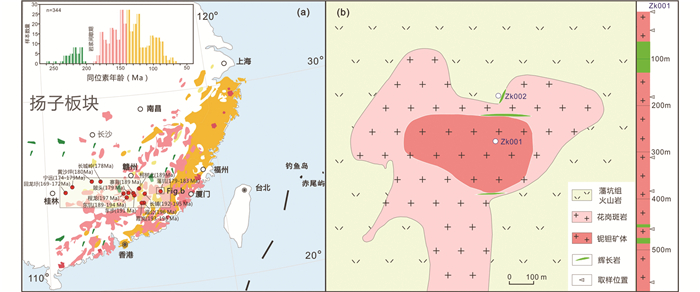
|
图 1 南岭北带200~170Ma玄武岩和花岗岩分布图(a, 据Gan et al., 2017)和福建永定地区地质简图(b, 据中国冶金地质总局第二地质勘查院地调报告,2016①修改) Fig. 1 The distribution of 200~170Ma basalts and granites in the northern Nanling belt (a, after Gan et al., 2017) and simplified geological map of the Yongding area, Fujian Province (b) |
① 中国冶金地质总局第二地质勘查院.2016.福建永定-南平地区稀有稀土矿调查评价报告
基于已经发表的的同位素数据统计(Zhou et al., 2006),传统观点认为早侏罗世(200~180Ma)存在一个岩浆间歇期(图 1a)。但是随着分析技术的进步,华南各类火成岩石又积累相当数量的高质量数据资料,发现在早侏罗世南岭地区存在一条E-W向的岩浆带(图 1a),东起福建永定地区,经江西寻乌、龙南、定南地区,广东始兴、梅州,湖南宜章、道县、宁远地区,全长500km和宽250km。以双峰式火山岩(OIB型玄武岩和流纹岩)和A型花岗岩、碱性正长岩、橄榄辉长岩、角闪辉长岩为主要组合特征(Li et al., 2003; 李献华等,2007),还伴随少量S型和I型花岗岩。这与前人认为在闽西-赣南-粤东地区发育一条侏罗世E-W向陆内伸展带(裂谷盆地群)是吻合的(舒良树等,2004)。关于南岭早侏罗世岩浆活动,虽然前人对其中的花岗岩(寨背、陂头、柯树北)及镁铁质岩石开展了部分研究,但是,关于其岩石成因及构造背景一直以来有着广泛的争议。例如,有学者认为这些花岗岩形成于印支运动的后造山伸展背景或者陆内伸展背景下(陈培荣等,2002;付建明等,2004;Chen et al., 2008);有的学者则认为它们的形成与古太平洋板块俯冲引发的弧后拉张背景有关(谢昕等,2005; Zhou et al., 2006;Jiang et al., 2009a, b; 余心起等,2009;He et al., 2010; Wang et al., 2011; Sun et al., 2012),也有学者认为这些花岗岩受从晚三叠世开始的古太平洋板块平板俯冲影响,与板片断离或板片破坏引起软流圈地幔物质的上涌有关(Li and Li, 2007; Zhu et al., 2010)。以上争议的关键在于目前仍无确切的资料来限定古特提斯构造域向古太平洋构造域转换的时代与空间位置。南岭构造带处于古特提斯构造域与古太平洋构造域的复合部位,是限定古特提斯构造域向古太平洋构造域转换时空的理想地区。
闽西南永定盆地位于南岭构造带的最东缘,区内出露大量的早侏罗世双峰式火山岩与侵入花岗斑岩,大坪岩体是近年来发现的一个具铌钽矿化的花岗斑岩体,铌钽含量达到花岗岩型铌钽矿床的最低工业品位,但其研究程度几乎空白,笔者挑选该岩体两个钻孔的新鲜样品进行系统的岩相学、锆石U-Pb年代学和原位Hf-O同位素分析,以查明其岩石成因及其动力学机制,这对制约该区两大构造域转换的时空关系具有重要意义。
1 地质背景南岭构造带呈东西向展布,其西侧以萍乡-桂林断裂与扬子新元古代造山带相接,东侧以政和-大埔断裂与东南沿海晚中生代火山-侵入杂岩带接触,北侧以茶陵-广昌隐伏断裂和武夷山褶皱带相连,南界为博白-岑溪断裂(舒良树,2006)。该构造带发育在华南前震旦纪-早古生代褶皱基底之上(舒良树等,2004;舒良树,2012),经历了早古生代末期、早中生代初期和晚中生代等多期构造-岩浆活动(Li et al.,2004;舒良树等,2004)。区内晚中生代的构造岩浆活动与稀有金属(W-Sn-Nb-Ta)伴生关系密切(Mao et al., 2013; Chen et al., 2016; Zhang et al., 2017b),广受大家关注。南岭构造带是研究华南东部从古特提斯构造域向古太平洋构造域转换的关键地区,而华南陆块东部边缘受太平洋板块俯冲作用的影响,一般认为从中晚侏罗世开始(Jahn et al., 1976; Zhou et al., 2006; Sun et al., 2007, 2012; He et al., 2010; Wang et al., 2011; Zhang et al., 2017c);还有学者认为是从白垩纪才开始的(Chen et al., 2008;邢光福等, 2008);甚至还有学者认为是从晚三叠世就已经开始了(Li et al., 2007)。
闽西南永定地区位于南岭构造带的最东缘,华夏板块东南缘。构造上位于政和-大埔北东向断裂、上杭-云霄北西向断裂及北东东向的永定-闽江口断裂的交汇部位.盆地周围分布有中-下元古界、下石炭统、下二叠统、上三叠统等地层,这些地层被后期花岗岩所侵入(马金清和王文腾,1993;刘永超等,2017)。政和-大埔断裂控制了早侏罗世与中-晚侏罗世火山活动的边界。其东南侧晚侏罗世火山岩喷发以带状形式产出,呈NE延伸,成分类似于岛弧玄武岩(Li et al., 2014c)。而其西北侧的早侏罗世火山岩则以火山喷发盆地形式产出,包括永定东北部的湖雷火山喷发盆地、永定东部的五湖火山喷发盆地及永定南部的大石凹-蓝地火山喷发盆地(许美辉,1993),岩石组分呈OIB特征,暗示软流圈地幔特征(周金城等,2005),可见二者火山机构和成因存在较大的差异。盆地内的早侏罗世火山-沉积地层被命名为“藩坑组”,藩坑组中流纹岩及同阶段的花岗斑岩的Rb-Sr等时线年龄为179~188Ma(许美辉,1993;周金城和陈荣,2001)。区内侵入岩分布广泛,主要以酸性、中酸性花岗岩为主,可划分为加里东期、海西期-印支期、燕山期3个侵入期,其中燕山期的侵入岩岩体规模最大(张振杰和左仁广,2015)。藩坑组酸性端元,特别是斜长流纹岩及潜花岗斑岩、潜石英斑岩与Cu、Sn、Mo、Nb、Ta多金属成矿关系密切(许美辉,1993)。
2 大坪花岗斑岩岩相学特征及分析方法大坪岩体位于永定区南部的大石凹-蓝地火山喷发盆地(图 1b),侵入到藩坑组火山岩中,岩体上部的铌钽含量达到花岗岩型铌钽矿床的工业品位。本文按照不同标高分段采集了两个钻孔岩芯样品,其中钻孔ZK001位于矿化体的最中心位置,Zk002位于矿体的边缘。大坪岩体主体为花岗斑岩,具斑状结构,颜色较浅。暗色矿物为云母类矿物(含量不到5%),主要为黑鳞云母,少量为富锂多硅白云母和多硅白云母(刘永超等,2017)。斑晶主要为石英、钾长石、钠长石,自形程度较高(图 2)。这些组成特征与宜春414矿床上部钠长石花岗岩中的锂云母花岗岩比较一致(李洁和黄小龙,2013)。岩体中的铌铁矿物组成更接近铌铁矿端员,主要包括铌铁矿、钽铌铁矿、钽铌锰矿、重钽铁矿、锡铁钽矿、硅-铌铁矿等稀有的铌钽矿物(图 2)。此外,岩体中有许多辉长岩脉侵入穿插。

|
图 2 福建大坪花岗斑岩手标本(a、b)和显微镜下钾长石和石英照片(c)及板状铌钽铁矿电子探针背散射图像(d) Fig. 2 Photos of specimens from the Daping granite porphyry (a, b), microphotograph of phenocrysts of quartz and feldspar (c) and backscattered image of columbite-tantalite (d) |
锆石分选采用重砂方法完成,首先将约2kg岩石样品破碎到60目,再经浮选和电磁选,分选出无磁性的重矿物,然后在双目镜下仔细挑选表面平整光洁且具不同柱锥面特征和不同颜色的锆石颗粒,然后将分选出不同特征的锆石颗粒排列在双面胶上,用混合有固化剂的环氧树脂胶结。待环氧树脂固化后,抛光至锆石颗粒中心露出,制成样品靶。然后对样品靶的锆石进行显微镜下透射光和反射光的观察和照相,以及阴极发光(CL)图像分析。制靶在中国科学院广州地球化学研究所同位素地球化学国家重点实验离子探针中心完成,CL图像分析在同位素国家重点实验电子探针微区分析实验室Gatan Mono CL3型阴极发光系统上完成。锆石SIMS原位U-Pb定年参数条件为,一次离子流为强度约8Na、束斑大小为20×30μm。δ18O分析条件为,一次离子流为强度约2nA、束斑大小为10μm,实验采用91500和清湖锆石作为标样。SIMS锆石U-Pb定年和δ18O分析均在同位素地球化学国家重点实验离子探针中心Cameca IMS 1280HR上完成,详细过程参考Li et al. (2009)。部分样品锆石原位U-Pb定年在中国科学院广州地球化学研究所中国科学院矿物与成矿学重点实验室完成,剥蚀束斑29μm,频率8Hz,所用仪器为激光剥蚀等离子质谱(LA-ICP-MS),其中剥蚀系统为Resolution S-155,剥蚀系统为Agilent 7900 ICP-MS,详细过程参考Li et al. (2012a) and Liu et al. (2016)。锆石原位Lu-Hf同位素分析在武汉上谱分析科技有限公司完成,剥蚀束斑44μm,频率8Hz,所用仪器为相干193nm准分子激光剥蚀系统(GeoLasPro HD)和多接收质谱MC-ICP-MS(Neptune Plus)。实验采用91500和GJ-1作为标样,91500的176Hf/177Hf比值为0.282310±25。εHf计算采用的176Lu的衰变常数为1.867×10-11(Scherer et al., 2001),球粒陨石176Hf/177Hf=0.282793,176Lu/177Hf=0.0332(Blichert-Toft and Albarède, 1997)。亏损地幔Hf模式年龄(tDM)采用176Hf/177Hf=0.283251,176Lu/177Hf= 0.0384计算(Vervoort and Blichert-Toft, 1999),二阶段Hf模式年龄(tDM2C)采用平均大陆壳176Lu/177Hf =0.015计算(Griffin et al., 2004)。
全岩粉末样品选择新鲜岩石样品用无污染颚式破碎机及玛瑙碾钵破碎至200目以下。全岩的主微量分析测试在中国科学院广州地球化学研究所同位素地球化学国家重点实验室完成。主量分析称取适量样品干燥后,放入马弗炉内进行900度灼烧以测其烧矢量,称取烧失后的样品,按1: 8的比例用纯四硼酸锂稀释后用1250℃的温度熔成玻璃,然后在Rigaku ZSX 100e X射线荧光光谱仪进行主量元素的分析,分析的精度优于1%。将样品烘干后的200目样品放入洗干净的杯子中,加入4N高纯硝酸3mL,在190℃的烘箱内加热4~6个小时,蒸干后用100mL 4N硝酸加热提取,加5mL milli-Q水摇匀后,用PE Elan 6000型ICP-MS分析微量元素组成。
3 分析结果 3.1 锆石U-Pb定年我们选择Zk001中ZL-4(230m)、ZL-10(485m)和ZL-11(595m)三个样品进行锆石U-Pb定年,其中ZL-4和ZL-10采用SIMS分析,ZL-11采用LA-ICP-MS分析(表 1)。由于样品ZL-4(230m)采样更浅,分异程度更高,与流体强烈相互作用,大部分锆石的晶格破坏,发生退晶化,没有获得很好的年龄数据,这里不做讨论。ZL-10(485m)和ZL-11(595m)分异程度相对较低,样品有许多锆石保留了结晶的形貌,没有发生退晶化(图 3),可以获得很好的谐和年龄和加权平均年龄。
|
|
表 1 大坪花岗斑岩LA-ICP-MS和SIMS锆石U-Pb定年结果 Table 1 LA-ICP-MS and SIMS zircons U-Pb dating results for the Daping granite porphyry |
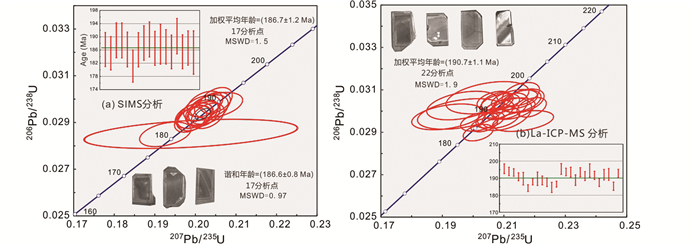
|
图 3 大坪花岗斑岩的锆石形貌和谐和年龄及加权平均年龄 Fig. 3 Zircon U-Pb concordian diagram, weighted average ages and morphology for the Daping granite porphyry |
样品ZL-10(485m),锆石多呈自形板状,选择无色透明没有包裹体和裂隙的锆石进行SIMS微区分析,17个分析点的Th/U比值变化于0.54~1之间,且绝大多数>0.6,其形态和CL图像显示出明显的振荡环带,都表明它们为典型的岩浆成因锆石。15颗锆石的206Pb/238U年龄变化于185~190Ma,普通铅含量很低,其中2颗锆石的206Pb/238U年龄偏小为181Ma,分析误差偏大。17颗锆石的206Pb/238U与207Pb/235U谐和年龄为为186.7±1.2Ma(MSWD=1.5),17颗锆石206Pb/238U加权平均年龄为186.6±0.8Ma(MSWD=0.97,图 3a)。样品ZL-11(595m),锆石形貌类似于ZL-10(485m),且它们的Th/U比值集中于0.3~1.0,绝大部分为典型的岩浆锆石特征,少数几颗可能为热液锆石。所测的22颗锆石的206Pb/238U年龄变化于184~196Ma,它们的加权平均年龄为190.7±1.1Ma(MSWD=1.9,图 3b)。综上,大坪花岗斑岩的形成时代为187~191Ma,与藩坑组火山岩活动时代近似,为早侏罗世岩浆活动产物。
3.2 岩石地球化学特征岩石地球化学分析显示大坪花岗岩的主量元素含量变化不是很大,但是随着空间变化显示一定的趋势(表 2)。总体特征为:硅较高(SiO2=72.81%~77.30%)、偏碱(全碱ALK(Na2O+K2O)=7.70%~10.03%),富钾(K2O =4.11%~5.87%),碱铝指数(AKI值)变化于0.55~0.73。在(K2O+Na2O)-SiO2图中落在亚碱性花岗岩系列区域,在A/NK-A/CNK图解上大部分落在弱过铝质范围(图 4)。这与同时期内陆200~170Ma呈E-W向展布的典型A型花岗岩,如赣南陂头岩体、寨背岩体和温公花岗岩(Zhu et al., 2010;甘成势等,2016; Gan et al., 2017)特征类似。此外,主量元素的Harker图解(图 5)上,大坪花岗斑岩普遍低Fe2O3T(0.87%~2.4%)、MnO (0.04%~0.24%)、MgO (0.17%~0.20%)、CaO (0.09%~0.62%)、TiO2 (0.01%~ 0.03%)和P2O5(0.01%~0.04%)。
|
|
表 2 大坪花岗斑岩的主量元素(wt%)和微量元素(×10-6)成分 Table 2 Major (wt%) and trace (×10-6) element compositions of the Daping granite porphyry |

|
图 4 大坪花岗斑岩(K2O+Na2O)-SiO2(a, 据Peccerillo and Taylor, 1976)和A/NK-A/CNK (b, 据Maniar and Piccoli, 1989)图解 Fig. 4 Diagrams of (K2O+SiO2) vs. SiO2 (a, after Peccerillo and Taylor, 1976) and A/NK vs. A/CNK (b, after Maniar and Piccoli, 1989) |
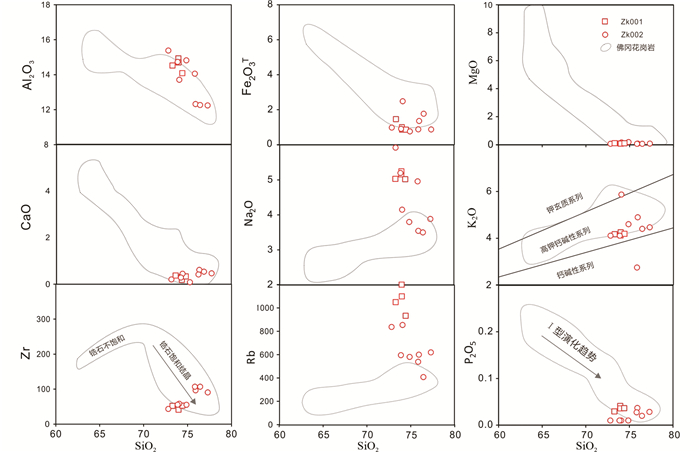
|
图 5 大坪花岗斑岩主量元素的Harker图解 佛冈岩体数据引自Li et al. (2007) Fig. 5 Harker diagrams for the Daping granite porphyry The data of Fogang granite is after Li et al. (2007) |
稀土元素配分曲线和微量元素蛛网图解如图 6。大坪岩体的ΣREE为56.2×10-6~218×10-6,(La/Yb)N=0.80~2.15,表明岩体轻重稀土元素分异不明显。δEu=0.04~0.29,具有明显的Eu负异常,δCe=0.75~1.27,无明显Ce异常,显示有明显的M型四分组效应(图 6a)。大坪岩体微量元素蛛网图整体呈现右倾的趋势,其中高场强元素Th、U、Ta、Nb、Hf等相对富集,大离子亲石元素Ba、Sr等相对亏损,Rb元素相对富集,有明显的Ti亏损(图 6b)。岩体有着高的Rb/Sr比值(24.5~140.2)和Y/Ho比值(19.5~36.7),低的Zr/Hf比值(4.1~11)和Nb/Ta比值(0.86~3.78)。

|
图 6 大坪花岗斑岩球粒陨石标准化稀土元素图解(a)和原始地幔标准化微量元素蛛网图(b)(标准化值据McDonough and Sun, 1995) Fig. 6 Chondrite-normalized REE pattern diagram (a) and primitive mantle-normalized trace element diagram (b) for the Daping granite porphyry (normalization values after McDonough and Sun, 1995) |
对其中SIMS定年样品ZL-10(485m)的锆石颗粒分别进行了原位Hf-O同位素测定,详细分析结果列于表 3。17颗锆石的Hf同位素变化比较大,均显示了比较亏损的源区特征,176Hf/177Hf=0.282617~0.282781,对应样品的εHf(t)=-2.4~3.44,εHf(t)加权平均值为0.75,tDMC为1.0~1.3Ga。与同期的A型花岗岩(陂头和温公岩体)特征类似。δ18O组成相对比较均一,δ18O=5.75‰~6.48‰,δ18O加权平均值为6.28‰,比幔源锆石的值稍高。
|
|
表 3 大坪花岗斑岩锆石的Hf-O同位素组成 Table 3 Zircon Hf-O isotopic compositions from the Daping granite porphyry |
不同类型(I-,S-和A-型)的高演化花岗岩,由于矿物组合和化学成分都趋近于最低共熔点组分,呈现相似的地球化学特征(尤其是微量元素行为)因而难以区分(Li et al., 2007;陈璟元和杨进辉,2015;Zhang et al., 2017a; 吴福元等,2017)。大坪花岗斑岩高硅(SiO2>72%),非常高的Rb/Sr比(24.5~140.2)和非常低的Zr/Hf(4.1~11)、Nb/Ta(0.86~3.78)比值,及明显的Eu负异常(0.04~0.29),表明岩石经历了强烈的结晶分异作用。大部分岩石样品表现为弱过铝质(A/CNK=0.97~1.10),只有2个样品采集于地表附近,A/CNK超过1.1,结合全岩较高的烧失量,因而推测这可能是地表风化导致的。其次,我们没有在薄片中发现S型花岗岩的典型过铝质矿物,如堇青石、白云母、石榴石等(Chappell et al., 1999)。样品的P2O5的含量很低(< 0.04%),与SiO2相关图上显示的负相关关系,符合HW磷灰石饱和规则(Harrison and Watson modal)并落入I型花岗岩的演化趋势线上(Harrison and Watson, 1984;李献华等,2007)。此外,样品中的锆石具有比较低的O同位素组成(~6.28‰),这与华南典型的S型大容山花岗岩也相差甚远。因此,大坪花岗斑岩不太可能是S型花岗岩。
高分异花岗岩与A型花岗岩,特别是铝质A型花岗岩就很难区分(Zhang et al., 2017a)。大坪花岗斑岩具高的Rb、REE、Nb、Ta、Ga、Y含量,及高的Fe2O3T/MgO比值,亏损Ba、Sr、P、Eu。样品的10000Ga/Al比值介于4.96~6.8,尽管远高于一般A型花岗岩10000Ga/Al比值(~2.6),但仍然落在A型花岗岩的范围(图 7a)(Whalen et al., 1987; Eby, 1990; King et al., 2001; Li et al., 2012b; Jiang et al., 2018a, b)。一般而言A型花岗岩有着比较高的Zr+Nb+Ce+Y含量特征,如陂头、温公、柯树北岩体,但是如果岩浆高度演化,通常会使其低于A型花岗岩的判断标准(~350×10-6)(Landenberger and Collins, 1996; Jiang et al., 2009a; Zhang et al., 2017a)。大坪花岗斑岩的Zr+Nb+Ce+Y含量随着采样深度变浅而逐渐降低,深部岩石分异程度偏低,有着更高的Zr+Nb+Ce+Y含量(~412×10-6)(图 7b)也符合A型花岗岩特征。判断A型花岗岩有一个重要特征就是来自于非造山带环境,而大坪花岗斑岩的样品全部落在板内环境环境(图 7c,d)。A型花岗岩还有一个最为重要的特征就是高温。根据锆饱和温度(Watson and Harrison, 1983),虽然大坪花岗斑岩的锆饱和温度很低(680~760℃),但是锆石的Ti温度计(Watson et al., 2006),却记录了非常高的温度(600~950℃)(图 8)。由于大坪花岗斑岩经历了显著的结晶分异,随着岩石的深度逐渐变浅,Zr的含量及Zr/Hf比值逐渐降低(图 9),表明现在全岩Zr含量可能并不能代表初始岩浆(Zhang et al., 2018)。而锆石是一种非常稳定的副矿物,贯穿岩浆演化始终,是最有可能反映岩浆真实温度的。因此,我们认为大坪花岗斑岩具有非常高的初始岩浆温度。虽然高分异的I型花岗岩,也能显示许多A型花岗岩的典型特征,如高的Ga/Al比值等,但是前人研究认为Ga/Al比值和Zr+Nb+Ce+Y含量两个指标综合使用能够提供有效的制约(Zhang et al., 2017a),结合大坪花岗斑岩的高温特征,我们更倾向认为其为A型花岗岩。
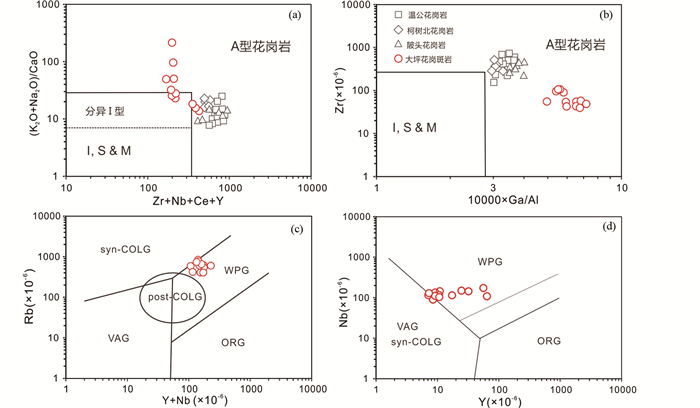
|
图 7 大坪花岗斑岩的(K2O+SiO2)/CaO-Zr+Nb+Ce+Y图解(a)、Zr-10000Ga/Al图解(b)、Rb-(Y+Nb)图解(c)和Nb-Y图解(d) (底图据Eby, 1990;Whalen et al., 1987) VAG-火山弧型;Syn-COLG-同碰撞型;WPG-板内型;ORG-洋脊型;Post-COLG-碰撞后型.其他岩体数据据Gan et al. (2017) Fig. 7 Plots of (K2O+SiO2)/CaO vs. Zr+Nb+Ce+Y (a), Zr vs. 10000Ga/Al(b), Rb vs. (Y+Nb) (c) and Nb vs. Y (d) for the Daping granite porphyry (base map after Eby, 1990; Whalen et al., 1987) VAG-volcanic-arc granite; Syn-COLG-syn-collision granite; WPG-within plate granite; ORG-ocean ridge granite; Post-COLG-post collision granite. The data of Wengong, Keshubei and Pitou granites after Gan et al. (2017) |
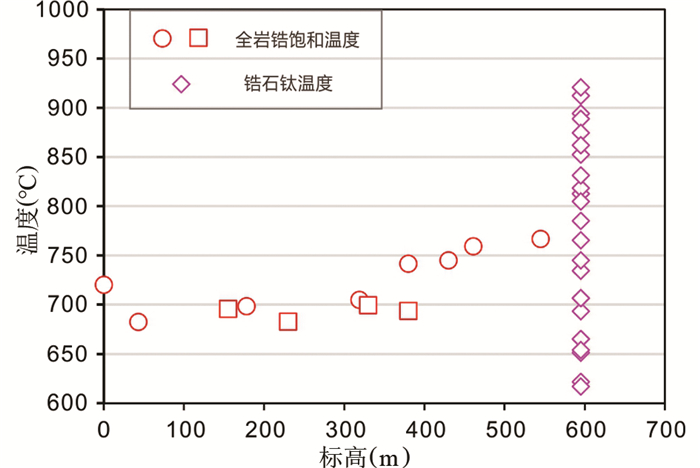
|
图 8 大坪花岗斑岩温度随深度变化图解 Fig. 8 Temperature-Depth diagram for the Daping granite porphyry |
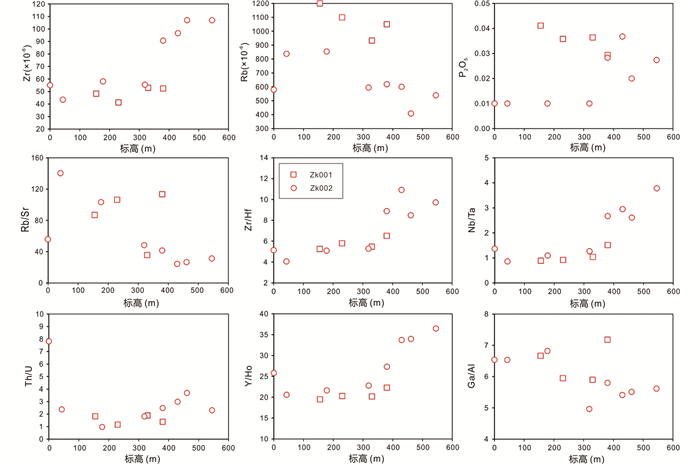
|
图 9 大坪花岗斑岩微量元素含量及比值随深度变化图解 Fig. 9 The contents and ratios of trace elements versus depth diagrams for the Daping granite porphyry |
目前有关A型花岗岩的成因存在广泛的争议,特别是其源区性质和形成过程。目前关于其源区主要有以下观点:1)幔源的碱性岩浆直接结晶分异(Eby, 1990; Bonin, 2007);2)先前经历过部分熔融-岩浆抽离后残留的难熔的下地壳麻粒岩相岩石的再熔(Collins et al., 1982; Whalen et al., 1987; King et al., 1997);3)浅部地壳底侵作用形成的钙碱性花岗岩的深熔(Creaser et al., 1991);4)拉斑质岩浆极度分异或者由亏损地幔演化而来的基性下地壳部分熔融(Frost et al., 1999);5)地壳花岗质岩浆与幔源的基性岩浆混合(Wickham et al., 1996; Yang et al., 2006; Li et al., 2012b; Chen et al., 2016)。另外,同时期南岭地区呈E-W向展布的典型A型花岗岩的成因也一直饱受争议,但是大量幔源岩浆的参与了岩体的形成是被广泛接受的(李献华等,2009)。
大坪花岗斑岩有着非常高的SiO2含量,除了K2O、Na2O、Al2O3含量变化明显,其它主量元素变化趋势并不明显。野外没有发现相伴生堆晶成因的中-基性岩石,Harker图解上也没有主量元素连续演化的趋势,因此大坪花岗斑岩似乎很难通过结晶分异形成。第二种解释虽然能形成A型花岗岩贫水富卤素的特征,却不能解释大坪花岗斑岩FeO/(FeO+MgO)>0.85这种富铁特征(Creaser et al., 1991)。更为重要的是锆石Hf-O同位素二端元混合模拟显示(图 10),母岩浆主要来源于亏损地幔,且混入了20%~30%的地壳物质。因此,大坪岩体也很难直接通过古老的地壳直接熔融形成。那么大坪花岗斑岩形成不外乎两种方式:1)亏损地幔演化而来的初生基性下地壳部分熔融。大概在新元古代中期(850~900Ma)武夷地区有大规模的幔源岩浆活动(Li et al., 2010),而这些幔源组分通过底侵方式形成初生地壳,这些基性岩锆石刚好有着与大坪相似的模式年龄(~1.2Ga),大概在190Ma左右,发生热事件诱发初生地壳发生部分熔融形成大坪花岗斑岩;2)幔源岩浆与壳源岩浆混合而成,在190Ma左右,岩石圈发生伸展,软流圈地幔减压部分熔融形成拉斑玄武质岩浆诱发部分古老的地壳物质熔融,并与之混合形成大坪花岗岩。另外,区内同时期广泛发育的藩坑组双峰式火山岩及辉长岩岩脉,显示OIB的岩石地球化学特征。这种OIB型玄武岩可作为该地区早侏罗世软流圈地幔上涌的岩石学标志(周金城等,2005)。因此,我们推测早侏罗世幔源岩浆的上涌不仅提供热量还参与大坪花岗斑岩的形成。

|
图 10 锆石Hf-O同位素相关关系图 点线为地幔和表壳沉积岩来源岩浆二元混合趋势线,Hfpm/Hfc代表幔源岩浆与壳源岩浆的Hf浓度比,线上空心圈代表混合比例(以10%为间隔).地幔端元的锆石εHf=12,δ18O=5.6‰来源于清湖二长岩,表壳沉积岩端元的锆石εHf=-12,δ18O=10‰.地幔端元及佛冈岩体数据李献华等(2009),温公岩体和陂头岩体数据引自Gan et al.(2017) Fig. 10 Plot of Hf vs. O isotopes of zircons from the Daping granite porphyry The dotted lines denote the two-component mixing trends between the mantle and supercrust derived magmas. Hfpm/Hfc is the ratio of Hf concentration in the parental mantle magma (pm) over crustal (c) melt indicated for each curves, and the small open circles on the curves represent 10% mixing increments by assuming the mantle zircon has εHf=12 and δ18O=5.6‰; the supercrustal zircon has εHf=-12 and δ18O=10‰. The data of the mantle end member and the Fogang granite is after Li et al. (2009), and the data of the Wengong granite and Pitou granite is after Gan et al. (2017) |
大部分铌-钽花岗岩体都表现出弱过铝质到过铝质和Nb、Ta含量随着岩浆演化程度增大而升高的特点(Dostal et al., 2000; Weyer et al., 2003;Van Lichtervelde et al., 2008),因此,花岗岩中的Nb、Ta富集与岩浆体系的高度演化有密切联系。在稀有金属花岗岩演化过程中,随着岩浆演化程度的升高而发生规律性变化,即熔体中的F、Rb、Li含量随着岩浆演化程度的升高而增加(李洁和黄小龙,2013)。大坪花岗斑岩含有较高的SiO2含量(高达77%)及宽的变化范围,稀土元素分布曲线具有M型四分组效应以及明显的Eu负异常,这是高分异稀有金属矿化花岗岩的重要标志。
关于花岗岩稀有金属成矿,国际上一直存在较大的争论。部分学者认为稀有金属相关花岗岩的Nb/Ta比值显著降低主要与岩浆的结晶分异有关(Stepanov et al., 2014; Zhang et al., 2017a, 2019)。由于Nb在云母中的分配系数大于Ta, 因而随着云母的分离结晶,残余溶体中Nb和Ta逐渐富集, 而Nb/Ta比值逐渐降低。而另外部分学者认为稀有金属花岗岩有着极低的Nb/Ta比值(< 5),模拟计算表明高达90%的分离结晶才能形成如此低的Nb/Ta比值,显然这在自然系统中是不可能的,而亚固相下的岩浆-热液过程在再次富集稀有金属元素和分异Nb-Ta过程中起了很重要的作用(Ballouard et al., 2016)。Nb和Ta被称为高场强元素,一般认为在热液中极其不活动的,但是最近的实验岩石学研究表明,在富氟的溶液体系中Nb和Ta是可以与氟形成络合物而被稳定迁移的(Timofeev et al., 2015, 2017)。
以ZK001为例(图 9),从下往上我们选择了一条剖面,我们发现随着标高变小,Rb含量及Rb/Sr比值显著升高,Nb/Ta、Zr/Hf、Th/U比值逐渐降低,而Nb和Ta的含量逐渐升高。在几百米的深度我们并没有观察到明显的结晶分异现象,因而我们更倾向认为Nb和Ta的富集与分异更多受控于岩浆-热液过程。大坪花岗岩全岩包含了较高的F含量(高达0.8%, 未发表数据),及野外露头和显微镜下都能观察到萤石,均表明岩石具有高的氟含量。全岩高的Y/Ho比值也说明流体与岩浆的相互作用(陈璟元和杨进辉,2015)。因此,我认为岩石高程度演化是大坪花岗斑岩成矿元素以及挥发组份高度富集的重要控制因素。而晚期富氟的流体出熔及向上迁移对稀有金属再次富集及Nb/Ta分异具有很重要的作用。
4.4 构造启示意义南岭燕山早期的火成岩是华南印支期造山运动后的板内岩浆活动,在200~70Ma期间出现了以玄武岩和A型酸性火山岩及其侵入相辉长岩和A型花岗岩的“双峰式”火成岩组合为特征,这些岩石分布于一个近E-W向展布的区域内,岩石组合表明它们形成于伸展拉张背景(图 1a)(李献华等,2007)。这些火成岩虽规模小但分布广泛,包括湘南宁远-新田碱性玄武岩(Li et al., 2004)、湘东南宜章长城岭拉斑玄武岩(赵振华等,1998)、赣南龙南东坑-临江盆地和寻乌白面石-菖蒲盆地拉斑玄武岩(陈培荣等,1999;Gan et al., 2017)、赣中吉安安塘碱性玄武岩(王岳军等,2004)和闽西南永定盆地拉斑玄武岩(周金城等,2005)。这些玄武岩均显示出洋岛玄武岩(OIB)的地球化学和同位素组成特征。目前报道的与双峰式火山岩相伴生的辉长岩与A型花岗岩(包括寨北、柯树北、温公、大坪A型花岗岩)同样显示相对亏损的同位素特征,表明这时期存在大量的软流圈地幔物质上涌。由于研究区刚好处于古特提斯构造域与古太平洋构造域的交界部位,而三叠纪-侏罗纪时期刚好处于两大构造域的转换时期(张岳桥等,2009;舒良树,2012;Wang et al., 2013),所以关于其成因存在不同观点。例如,部分学者认为此岩石组合是继三叠纪印支地块与华南地块碰撞造山(Carter et al., 2001)以后的一种后造山大陆裂解地球动力背景下的产物,持续到早侏罗世(陈培荣等,2002;付建明等,2004; Chen et al., 2008)。而部分学者提出质疑,广泛出露三叠纪的A型花岗岩的时代为229~215Ma(王丽娟等,2007;Zhao et al., 2013;Gan et al., 2017),可能标志碰撞后广泛的伸展活动,而215Ma以后伸展已经结束,伸展很难持续到~170Ma,况且在全球的典型的造山带也几乎没有碰撞后伸展持续近50Ma的先例。Li and Li(2007)认为华南广泛的陆内变形与三叠-白垩纪的岩浆活动可能都受控于古太平洋的俯冲作用,继而提出了一个平板俯冲的模型,在三叠纪古太平洋板块向西俯冲形成1300 km范围的陆内变形,大概在晚侏罗世末,由于板片后撤,导致平坦的板片发生破坏或撕裂,形成了广泛的晚中生代岩浆活动。由于没有在华南发现板片熔融的埃达克岩及弧相关与非弧相关的岩石组合,晚侏罗世的岩浆岩基本为板内环境,因此这个模型也遭到大家的广泛质疑。Zhou et al.(2006)提出古太平洋板块两阶段模型,侏罗纪的岩浆活动主要与初始俯冲相关,属于板内阶段;但是随后的白垩纪岩浆活动,才是活动大陆边缘环境。因此,部分学者认为200~170Ma的岩浆活动可能与俯冲初始阶段相关,古太平洋板块俯冲的远程效应导致先存在的断裂活化,诱导南岭局部大规模的伸展,并伴随着大量的软流圈地幔上涌(谢昕等,2005; Jiang et al., 2009a; 余心起等,2009; He et al., 2010; Yu et al., 2010; Gan et al., 2017; Zhou et al., 2018)。对此很多学者也提出质疑,认为NE向俯冲如何形成近W-E的伸展作用,在几何学上很难实现。总之,就像上面讨论,晚三叠世的A型花岗岩形成于碰撞后伸展背景,属于古特提斯构造域。而晚侏罗-早白垩世A型花岗岩主要形成与弧后伸展环境,受控于古太平洋构造域(邱检生等,1999; Zhou et al., 2006; 肖娥等,2007; Wang et al., 2011; 林清茶等,2011; Sun et al., 2012; Chen et al., 2013; Gan et al., 2017)。而200~170Ma近E-W向岩浆活动与构造伸展,可能标志着两大构造域在早侏罗世发生转折,但是关于其成因需要我们进一步的工作。
5 结论(1) 大坪花岗斑岩SIMS锆石U-Pb年龄和LA-ICP-MS锆石U-Pb年龄分别为186.7±1.2Ma和190.7±1.1Ma,是区内首次报道早侏罗世A型花岗岩Nb-Ta成矿事件。
(2) 大坪花岗斑岩的Hf-O同为素揭示其源区大概70%~80%软流圈地幔物质,且混合或混染20% ~30%的地壳物质。
(3) 大坪花岗斑岩与闽西南地区同时期的火山岩,如藩坑组双峰式火山岩,在空间上可与前人提出的“南岭山脉早侏罗世发育的东西向裂谷岩浆岩带(OIB型玄武岩、辉长岩和A型花岗岩组合)”相对应,是该裂谷带向东的延伸。
致谢 野外地质工作得到了中国冶金地质总局第二地质勘查院叶盛源工程师的帮助;中国科学院海洋研究所孙卫东研究员对本文给予了指导;中国科学院广州地球化学研究所夏小平研究员及中国冶金地质总局山东局测试中心林培军、王继林等工程师对测试提供了帮助;审稿人及编辑部老师等对本文成稿提出了修改意见;在此一并表示衷心感谢!
Ballouard C, Poujol M, Boulvais P, Branque Y, Tartèse R and Vigneresse JL. 2016. Nb-Ta fractionation in peraluminous granites:A marker of the magmatic-hydrothermal transition. Geology, 44(3): 231-234 DOI:10.1130/G37475.1 |
Blichert-Toft J and Albarède F. 1997. The Lu-Hf isotope geochemistry of chondrites and the evolution of the mantle-crust system. Earth and Planetary Science Letters, 148(1-2): 243-258 DOI:10.1016/S0012-821X(97)00040-X |
Bonin B. 2007. A-type granites and related rocks:Evolution of a concept, problems and prospects. Lithos, 97(1-2): 1-29 DOI:10.1016/j.lithos.2006.12.007 |
Carter A, Roques D, Bristow C and Kinny P. 2001. Understanding Mesozoic accretion in Southeast Asia:Significance of Triassic thermotectonism (Indosinian orogeny) in Vietnam. Geology, 29(3): 211-214 DOI:10.1130/0091-7613(2001)029<0211:UMAISA>2.0.CO;2 |
Chappell BW. 1999. Aluminium saturation in I-and S-type granites and the characterization of fractionated haplogranites. Lithos, 46(3): 535-551 DOI:10.1016/S0024-4937(98)00086-3 |
Chen CH, Lee CY and Shinjo R. 2008. Was there Jurassic paleo-Pacific subduction in South China? Constraints from 40Ar/39Ar dating, elemental and Sr-Nd-Pb isotopic geochemistry of the Mesozoic basalts. Lithos, 106(1-2): 83-92 DOI:10.1016/j.lithos.2008.06.009 |
Chen JY, Yang JH, Zhang JH, Sun JF and Wilde SA. 2013. Petrogenesis of the Cretaceous Zhangzhou batholith in southeastern China:Zircon U-Pb age and Sr-Nd-Hf-O isotopic evidence. Lithos, 162-163: 140-156 DOI:10.1016/j.lithos.2013.01.003 |
Chen JY and Yang JH. 2015. Petrogenesis of the Fogang highly fractionated I-type granitoids:Constraints from Nb, Ta, Zr and Hf. Acta Petrologica Sinica, 31(3): 846-854 (in Chinese with English abstract) |
Chen PR, Kong XG, Ni QS, Zhang BT and Liu CS. 1999. Ascertainment and implication of the Early Yianshanian bimodal volcanic associations from South Jiangxi Province. Geological Review, 45(Suppl.1): 734-741 (in Chinese with English abstract) |
Chen PR, Hua RM, Zhang BT, Lu JJ and Fan CF. 2002. Early Yanshanian post-orogenic granitoids in the Nanling region:Petrological constraints and geodynamic settings. Science in China (Series D), 45(8): 755-768 |
Chen YX, Li H, Sun WD, Ireland T, Tian XF, Hu YB, Yang WB, Chen C and Xu DR. 2016. Generation of Late Mesozoic Qianlishan A2-type granite in Nanling Range, South China:Implications for Shizhuyuan W-Sn mineralization and tectonic evolution. Lithos, 266-267: 435-452 DOI:10.1016/j.lithos.2016.10.010 |
Collins WJ, Beams SD, White AJR and Chappell BW. 1982. Nature and origin of A-type granites with particular reference to southeastern Australia. Contributions to Mineralogy and Petrology, 80(2): 189-200 DOI:10.1007/BF00374895 |
Creaser RA, Price RC and Wormald RJ. 1991. A-type granites revisited:Assessment of a residual-source model. Geology, 19(2): 163-166 DOI:10.1130/0091-7613(1991)019<0163:ATGRAO>2.3.CO;2 |
Dostal J and Chatterjee AK. 2000. Contrasting behaviour of Nb/Ta and Zr/Hf ratios in a peraluminous granitic pluton (Nova Scotia, Canada). Chemical Geology, 163(1-4): 207-218 DOI:10.1016/S0009-2541(99)00113-8 |
Eby GN. 1990. The A-type granitoids:A review of their occurrence and chemical characteristics and speculations on their petrogenesis. Lithos, 26(1-2): 115-134 DOI:10.1016/0024-4937(90)90043-Z |
Frost CD, Frost BR, Chamberlain KR and Edwards BR. 1999. Petrogenesis of the 1.43Ga Sherman Batholith, SE Wyoming, USA:A reduced, Rapakivi-type anorogenic granite. Journal of Petrology, 40(12): 1771-1802 DOI:10.1093/petroj/40.12.1771 |
Fu JM, Ma CQ, Xie CF, Zhang YM and Peng SB. 2004. Geochemistry and tectonic setting of Xishan aluminous A-type granitic volcanic-intrusive complex, southern Hunan. Journal of Earth Sciences and Environment, 26(4): 15-23 (in Chinese with English abstract) |
Gan CS, Wang YJ, Cai YF, Liu HC, Zhang YZ, Song JJ and Guo XF. 2016. The petrogenesis and tectonic implication of Wengong intrusion in the Nanling Range. Earth Science, 41(1): 17-34 (in Chinese with English abstract) |
Gan CS, Wang YJ, Qian X, Bi MW and He HY. 2017. Constraints of the Xialan gabbroic intrusion in the eastern Nanling Range on the Early Jurassic intra-continental extension in eastern South China. Journal of Asian Earth Sciences, 145: 576-590 DOI:10.1016/j.jseaes.2017.06.023 |
Griffin WL, Belousova EA, Shee SR, Pearson NJ and O'Reilly SY. 2004. Archean crustal evolution in the northern Yilgarn Craton:U-Pb and Hf-isotope evidence from detrital zircons. Precambrian Research, 131(3-4): 231-282 DOI:10.1016/j.precamres.2003.12.011 |
Harrison TM and Watson EB. 1984. The behavior of apatite during crustal anatexis:Equilibrium and kinetic considerations. Geochimica et Cosmochimica Acta, 48(7): 1467-1477 DOI:10.1016/0016-7037(84)90403-4 |
He ZY, Xu XS and Niu YL. 2010. Petrogenesis and tectonic significance of a Mesozoic granite-syenite-gabbro association from inland South China. Lithos, 119(3-4): 621-641 DOI:10.1016/j.lithos.2010.08.016 |
Jahn BM, Chen PY and Yen TP. 1976. Rb-Sr ages of granitic rocks in southeastern China and their tectonic significance. Geological Society of America Bulletin, 87(5): 763-776 DOI:10.1130/0016-7606(1976)87<763:RAOGRI>2.0.CO;2 |
Jiang N, Zhang SQ, Zhou WG and Liu YS. 2009a. Origin of a Mesozoic granite with A-type characteristics from the North China craton:Highly fractionated from I-type magmas?. Contributions to Mineralogy and Petrology, 158(1): 113-130 DOI:10.1007/s00410-008-0373-2 |
Jiang XY, Li H, Ding X, Wu K, Guo J, Liu JQ and Sun WD. 2018a. Formation of A-type granites in the Lower Yangtze River Belt:A perspective from apatite geochemistry. Lithos, 304-307: 125-134 DOI:10.1016/j.lithos.2018.02.005 |
Jiang XY, Luo JC, Guo J, Wu K, Zhang ZK, Sun WD and Xia XP. 2018b. Geochemistry of I-and A-type granites of the Qingyang-Jiuhuashan complex, eastern China:Insights into early cretaceous multistage magmatism. Lithos, 316-317: 278-294 DOI:10.1016/j.lithos.2018.07.025 |
Jiang YH, Jiang SY, Dai BZ, Liao SY, Zhao KD and Ling HF. 2009b. Middle to Late Jurassic felsic and mafic magmatism in southern Hunan Province, Southeast China:Implications for a continental arc to rifting. Lithos, 107(3-4): 185-204 DOI:10.1016/j.lithos.2008.10.006 |
King PL, White AJR, Chappell BW and Allen CM. 1997. Characterization and origin of aluminous A-type granites from the Lachlan Fold Belt, Southeastern Australia. Journal of Petrology, 38(3): 371-391 DOI:10.1093/petroj/38.3.371 |
King PL, Chappell BW, Allen CM and White AJR. 2001. Are A-type granites the high-temperature felsic granites? Evidence from fractionated granites of the Wangrah Suite. Australian Journal of Earth Sciences, 48(4): 501-514 DOI:10.1046/j.1440-0952.2001.00881.x |
Landenberger B and Collins WJ. 1996. Derivation of A-type granites from a dehydrated charnockitic lower crust:Evidence from the Chaelundi Complex, eastern Australia. Journal of Petrology, 37(1): 145-170 DOI:10.1093/petrology/37.1.145 |
Li CY, Zhang H, Wang FY, Liu JQ, Sun YL, Hao XL, Li YL and Sun WD. 2012a. The formation of the Dabaoshan porphyry molybdenum deposit induced by slab rollback. Lithos, 150: 101-110 DOI:10.1016/j.lithos.2012.04.001 |
Li H, Ling MX, Li CY, Zhang H, Ding X, Yang XY, Fan WM, Li YL and Sun WD. 2012b. A-type granite belts of two chemical subgroups in central eastern China:Indication of ridge subduction. Lithos, 150: 26-36 DOI:10.1016/j.lithos.2011.09.021 |
Li H, Ling MX, Ding X, Zhang H, Li CY, Liu DY and Sun WD. 2014a. The geochemical characteristics of Haiyang A-type granite complex in Shandong, eastern China. Lithos, 200-201: 142-156 DOI:10.1016/j.lithos.2014.04.014 |
Li H, Watanabe K and Yonezu K. 2014b. Geochemistry of A-type granites in the Huangshaping polymetallic deposit (South Hunan, China):Implications for granite evolution and associated mineralization. Journal of Asian Earth Sciences, 88: 149-167 DOI:10.1016/j.jseaes.2014.03.004 |
Li J and Huang XL. 2013. Mechanism of Ta-Nb enrichment and magmatic evolution in the Yashan granites, Jiangxi Province, South China. Acta Petrologica Sinica, 29(12): 4311-4322 (in Chinese with English abstract) |
Li XH, Chen ZG, Liu DY and Li WX. 2003. Jurassic gabbro-granite-syenite suites from southern Jiangxi Province, SE China:Age, origin, and tectonic significance. International Geology Review, 45(10): 898-921 DOI:10.2747/0020-6814.45.10.898 |
Li XH, Chung SL, Zhou HW, Lo CH, Liu Y and Chen CH. 2004. Jurassic intraplate magmatism in southern Hunan-eastern Guangxi:40Ar/39Ar dating, geochemistry, Sr-Nd isotopes and implications for the tectonic evolution of SE China. In:Malpas J, Fletcher CJ, Aitchison JC and Ali J (eds.). Aspects of the Tectonic Evolution of China. Geological Society, London, Special Publications, 226:193-215 http://d.old.wanfangdata.com.cn/NSTLQK/10.1144-GSL.SP.2004.226.01.11/
|
Li XH, Li ZX, Li WX, Liu Y, Yuan C, Wei GJ and Qi CS. 2007. U-Pb zircon, geochemical and Sr-Nd-Hf isotopic constraints on age and origin of Jurassic I-and A-type granites from central Guangdong, SE China:A major igneous event in response to foundering of a subducted flat-slab?. Lithos, 96(1-2): 186-204 DOI:10.1016/j.lithos.2006.09.018 |
Li XH, Li WX and Li ZX. 2007. On the genetic classification and tectonic implications of the Early Yanshanian granitoids in the Nanling Range, South China. Chinese Science Bulletin, 52(14): 1873-1885 DOI:10.1007/s11434-007-0259-0 |
Li XH, Liu Y, Li QL, Guo CH and Chamberlain KR. 2009. Precise determination of Phanerozoic zircon Pb/Pb age by multicollector SIMS without external standardization. Geochemistry, Geophysics, Geosystems, 10(4): Q04010 |
Li XH, Li WX, Wang XC, Li QL, Liu Y and Tang GQ. 2009. Role of mantle-derived magma in genesis of Early Yanshanian granites in the Nanling Range, South China:In situ zircon Hf-O isotopic constraints. Science in China (Series D), 52(9): 1262-1278 DOI:10.1007/s11430-009-0117-9 |
Li Z, Qiu JS and Yang XM. 2014c. A review of the geochronology and geochemistry of Late Yanshanian (Cretaceous) plutons along the Fujian coastal area of southeastern China:Implications for magma evolution related to slab break-off and rollback in the Cretaceous. Earth-Science Reviews, 128: 232-248 DOI:10.1016/j.earscirev.2013.09.007 |
Li ZX and Li XH. 2007. Formation of the 1300-km-wide intracontinental orogen and postorogenic magmatic province in Mesozoic South China:A flat-slab subduction model. Geology, 35(2): 179-182 DOI:10.1130/G23193A.1 |
Li ZX, Li XH, Wartho JA, Clark C, Li WX, Zhang CL and Bao CD. 2010. Magmatic and metamorphic events during the Early Paleozoic Wuyi-Yunkai orogeny, southeastern South China:New age constraints and pressure-temperature conditions. Geological Society of America Bulletin, 122(5-6): 772-793 DOI:10.1130/B30021.1 |
Lin J, Liu YS, Yang YH and Hu ZC. 2016. Calibration and correction of LA-ICP-MS and LA-MC-ICP-MS analyses for element contents and isotopic ratios. Solid Earth Sciences, 1(1): 5-27 DOI:10.1016/j.sesci.2016.04.002 |
Lin QC, Cheng XW, Zhang YQ and Wang FY. 2011. Evolution of granitoids in the active continental margin:A case study of the Fuzhou compound complex. Acta Geologica Sinica, 85(7): 1128-1133 (in Chinese with English abstract) |
Liu YC, Li JK, Zou TR, Jiang SY, Hu MY and Chen ZY. 2017. Enrichment characteristics of Nb and Ta of Daping granite porphyry in Yongding, Fujian Province. Mineral Deposits, 36(1): 143-157 (in Chinese with English abstract) |
Ma JQ and Wang WT. 1993. Basic characteristics and the stratigraphic-time basis of Middle and Lower Proterozoic metamorphic rocks in the Yongding area of Fujian Province. Geology of Fujian, 12(4): 268-279 (in Chinese with English abstract) |
Maniar PD and Piccoli PM. 1989. Tectonic discrimination of granitoids. Geological society of America bulletin, 101(5): 635-643 DOI:10.1130/0016-7606(1989)101<0635:TDOG>2.3.CO;2 |
McDonough WF and Sun SS. 1995. The composition of the Earth. Chemical geology, 120(3-4): 223-253 DOI:10.1016/0009-2541(94)00140-4 |
Mao JW, Cheng YB, Chen MH and Pirajno F. 2013. Major types and time-space distribution of Mesozoic ore deposits in South China and their geodynamic settings. Mineralium Deposita, 48(3): 267-294 DOI:10.1007/s00126-012-0446-z |
Peccerillo A and Taylor SR. 1976. Geochemistry of Eocene calc-alkaline volcanic rocks from the Kastamonu area, northern Turkey. Contributions to Mineralogy and Petrology, 58(1): 63-81 DOI:10.1007/BF00384745 |
Qiu JS, Wang DZ and McInnes BAI. 1999. Geochemistry and petrogenesis of the I-and A-type composite granite masses in the coastal area of Zhejiang and Fujian provinces. Acta Petrologica Sinica, 15(2): 237-246 (in Chinese with English abstract) |
Scherer E, Münker C and Mezger K. 2001. Calibration of the lutetium-hafnium clock. Science, 293(5530): 683-687 DOI:10.1126/science.1061372 |
Shu LS, Zhou XM, Deng P, Yu XQ, Wang B and Zu FP. 2004. Geological features and tectonic evolution of Meso-Cenozoic basins in southeastern China. Geological Bulletin of China, 23(9-10): 876-884 (in Chinese with English abstract) |
Shu LS. 2006. Predevonian tectonic evolution of South China:From Cathaysian block to Caledonian Period folded orogenic belt. Geological Journal of China Universities, 12(4): 418-431 (in Chinese with English abstract) |
Shu LS. 2012. An analysis of principal features of tectonic evolution in South China Block. Geological Bulletin of China, 31(7): 1035-1053 (in Chinese with English abstract) |
Stepanov A, Mavrogenes JA, Meffre S and Davidson P. 2014. The key role of mica during igneous concentration of tantalum. Contributions to Mineralogy Petrology, 167: 1009 DOI:10.1007/s00410-014-1009-3 |
Sun WD, Ding X, Hu YH and Li XH. 2007. The golden transformation of the Cretaceous plate subduction in the West Pacific. Earth and Planetary Science Letters, 262(3-4): 533-542 DOI:10.1016/j.epsl.2007.08.021 |
Sun WD, Yang XY, Fan WM and Wu FY. 2012. Mesozoic large scale magmatism and mineralization in South China:Preface. Lithos, 150: 1-5 DOI:10.1016/j.lithos.2012.06.028 |
Timofeev A, Migdisov AA and Williams-Jones AE. 2015. An experimental study of the solubility and speciation of niobium in fluoride-bearing aqueous solutions at elevated temperature. Geochimica et Cosmochimica Acta, 158: 103-111 DOI:10.1016/j.gca.2015.02.015 |
Timofeev A, Migdisov AA and Williams-Jones AE. 2017. An experimental study of the solubility and speciation of tantalum in fluoride-bearing aqueous solutions at elevated temperature. Geochimica et Cosmochimica Acta, 197: 294-304 DOI:10.1016/j.gca.2016.10.027 |
Van Lichtervelde M, Grégoire M, Linnen RL, Béziat D and Salvi S. 2008. Trace element geochemistry by laser ablation ICP-MS of micas associated with Ta mineralization in the Tanco pegmatite, Manitoba, Canada. Contributions to Mineralogy and Petrology, 155(6): 791-806 DOI:10.1007/s00410-007-0271-z |
Vervoort JD and Blichert-Toft J. 1999. Evolution of the depleted mantle:Hf isotope evidence from juvenile rocks through time. Geochimica et Cosmochimica Acta, 63(3-4): 533-556 DOI:10.1016/S0016-7037(98)00274-9 |
Wang FY, Ling MX, Ding X, Hu YH, Zhou JB, Yang XY, Liang HY, Fan WM and Sun WD. 2011. Mesozoic large magmatic events and mineralization in SE China:Oblique subduction of the Pacific plate. International Geology Review, 53(5-6): 704-726 DOI:10.1080/00206814.2010.503736 |
Wang LJ, Yu JH, Xu XS, Xie L, Qiu JS and Sun T. 2007. Formation age and origin of the Gutian-Xiaotao granitic complex in the southwestern Fujian Province, China. Acta Petrologica Sinica, 23(6): 1470-1484 (in Chinese with English abstract) |
Wang YJ, Liao CL, Fan WM and Peng TP. 2004. Early Mesozoic OIB-type alkaline basalt in central Jiangxi Province and its tectonic implications. Geochimica, 33(2): 109-117 (in Chinese with English abstract) |
Wang YJ, Fan WM, Zhang GW and Zhang YH. 2013. Phanerozoic tectonics of the South China Block:Key observations and controversies. Gondwana Research, 23(4): 1273-1305 DOI:10.1016/j.gr.2012.02.019 |
Watson EB and Harrison TM. 1983. Zircon saturation revisited:Temperature and composition effects in a variety of crustal magma types. Earth and Planetary Science Letters, 64(2): 295-304 DOI:10.1016/0012-821X(83)90211-X |
Watson EB, Wark DA and Thomas JB. 2006. Crystallization thermometers for zircon and rutile. Contributions to Mineralogy and Petrology, 151(4): 413-433 DOI:10.1007/s00410-006-0068-5 |
Weyer S, Münker C and Mezger K. 2003. Nb/Ta, Zr/Hf and REE in the depleted mantle:Implications for the differentiation history of the crust-mantle system. Earth and Planetary Science Letters, 205(3-4): 309-324 DOI:10.1016/S0012-821X(02)01059-2 |
Whalen JB, Currie KL and Chappell BW. 1987. A-type granites:Geochemical characteristics, discrimination and petrogenesis. Contributions to Mineralogy and Petrology, 95(4): 407-419 DOI:10.1007/BF00402202 |
Wickham SM, Alberts AD, Zanvilevich AN, Litvinovsky BA, Bindeman IN and Schauble EA. 1996. A stable isotope study of anorogenic magmatism in East Central Asia. Journal of Petrology, 37(5): 1063-1095 DOI:10.1093/petrology/37.5.1063 |
Wu FY, Liu XC, Ji WQ, Wang JM and Yang L. 2017. Highly fractionated granites:Recognition and research. Science China (Earth Sciences), 60(7): 1201-1219 DOI:10.1007/s11430-016-5139-1 |
Xiao E, Qiu JS, Xu XS, Jiang SY, Hu J and Li Z. 2007. Geochronology and geochemistry of the Yaokeng alkaline granitic pluton in Zhejiang Province:Petrogenetic and tectonic implications. Acta Petrologica Sinica, 23(6): 1431-1440 (in Chinese with English abstract) |
Xie X, Xu XS, Zou HB, Jiang SY, Zhang M and Qiu JS. 2005. Early J2 basalts in SE China:Incipience of large-scale Late Mesozoic magmatism. Science in China (Series D), 49: 796-815 |
Xing GF, Lu QD, Chen R, Zhang ZY, Nie TC, Li LM, Huang JL and Lin M. 2018. Study on the ending time of Late Mesozoic tectonic regime transition in South China:Comparing to the Yanshan area in North China. Acta Geologica Sinica, 82(4): 451-463 (in Chinese with English abstract) |
Xu MH. 1993. Basic characteristics of Early Jurassic volcanic-eruption basin in Wuhu, Yongding County, Fujian Province. Geology of Fujian, 12(3): 202-209 (in Chinese with English abstract) |
Yang JH, Wu FY, Chung SL, Wilde SA and Chu MF. 2006. A hybrid origin for the Qianshan A-type granite, Northeast China:Geochemical and Sr-Nd-Hf isotopic evidence. Lithos, 89(1-2): 89-106 DOI:10.1016/j.lithos.2005.10.002 |
Yu XQ, Wu GG, Zhao XX, Gao JF, Di YJ, Zheng Y, Dai YP, Li CL and Qiu JT. 2010. The Early Jurassic tectono-magmatic events in southern Jiangxi and northern Guangdong provinces, SE China:Constraints from the SHRIMP zircon U-Pb dating. Journal of Asian Earth Sciences, 39(5): 408-422 DOI:10.1016/j.jseaes.2010.04.008 |
Yu XQ, Di YJ, Wu GG, Zhang D, Zheng Y and Dai YP. 2009. The Early Jurassic magmatism in northern Guangdong Province, southeastern China:Constraints from SHRIMP zircon U-Pb dating of Xialan complex. Science in China (Series D), 52(4): 471-483 DOI:10.1007/s11430-009-0038-7 |
Zhang CC, Sun WD, Wang JT, Zhang LP, Sun SJ and Wu K. 2017c. Oxygen fugacity and porphyry mineralization:A zircon perspective of Dexing porphyry Cu deposit, China. Geochimica et Cosmochimica Acta, 206: 343-363 DOI:10.1016/j.gca.2017.03.013 |
Zhang LP, Zhang RQ, Hu YB, Liang JL, Ouyang ZX, He JJ, Chen YX, Guo J and Sun WD. 2017a. The formation of the Late Cretaceous Xishan Sn-W deposit, South China:Geochronological and geochemical perspectives. Lithos, 290-291: 253-268 DOI:10.1016/j.lithos.2017.08.013 |
Zhang LP, Zhang RQ, Wu K, Chen YX, Li CY, Hu YB, He JJ, Liang JL and Sun WD. 2018. Late Cretaceous granitic magmatism and mineralization in the Yingwuling W-Sn deposit, South China:Constraints from zircon and cassiterite U-Pb geochronology and whole-rock geochemistry. Ore Geology Reviews, 96: 115-129 DOI:10.1016/j.oregeorev.2018.04.012 |
Zhang LP, Zhang RQ, Chen YX, Sun SJ, Liang JL and Sun WD. 2019. Geochronology and geochemistry of the Late Cretaceous Xinpeng granitic intrusion, South China:Implication for Sn-W mineralization. Ore Geology Reviews, 113: 103075 DOI:10.1016/j.oregeorev.2019.103075 |
Zhang RQ, Lu JJ, Lehmann B, Li CY, Li GL, Zhang LP, Guo J and Sun WD. 2017b. Combined zircon and cassiterite U-Pb dating of the Piaotang granite-related tungsten-tin deposit, southern Jiangxi tungsten district, China. Ore Geology Reviews, 82: 268-284 DOI:10.1016/j.oregeorev.2016.10.039 |
Zhang YQ, Xu XB, Jia D and Shu LS. 2009. Deformation record of the change from Indosinian collision-related tectonic system to Yanshanian subduction-related tectonic system in South China during the Early Mesozoic. Earth Science Frontiers, 16(1): 234-247 (in Chinese with English abstract) |
Zhang ZJ and Zuo RG. 2015. Tectonic evolution of southwestern Fujian Province and spatial-temporal distribution regularity of mineral deposits. Acta Petrologica Sinica, 31(1): 217-229 (in Chinese with English abstract) |
Zhao KD, Jiang SY, Chen WF, Chen PR and Ling HF. 2013. Zircon U-Pb chronology and elemental and Sr-Nd-Hf isotope geochemistry of two Triassic A-type granites in South China:Implication for petrogenesis and Indosinian transtensional tectonism. Lithos, 160-161: 292-306 DOI:10.1016/j.lithos.2012.11.001 |
Zhao ZH, Bao ZW and Zhang BY. 1998. Geochemistry of the Mesozoic basaltic rocks in southern Hunan Province. Science China (Series D), 41: 102-112 DOI:10.1007/BF02875640 |
Zhou JC and Chen R. 2001. Geochemistry of late Mesozoic interaction between crust and mantle in southeastern Fujian Province. Geochimica, 30(6): 547-558 (in Chinese with English abstract) |
Zhou JC, Jiang SY, Wang XL, Yang JQ and Zhang MQ. 2006. Study on lithogeo-chemistry of Middle Jurassic basalts from southern China represented by the Fankeng basalts from Yongding of Fujian Province. Science in China (Series D), 49(10): 1020-1031 DOI:10.1007/s11430-006-1020-2 |
Zhou XM, Sun T, Shen WZ, Shu LS and Niu YL. 2006. Petrogenesis of Mesozoic granitoids and volcanic rocks in South China:A response to tectonic evolution. Episodes, 29(1): 26-33 DOI:10.18814/epiiugs/2006/v29i1/004 |
Zhou ZM, Ma CQ, Wang LX, Chen SG, Xie CF, Li Y and Liu W. 2018. A source-depleted Early Jurassic granitic pluton from South China:Implication to the Mesozoic juvenile accretion of the South China crust. Lithos, 300-301: 278-290 DOI:10.1016/j.lithos.2017.11.017 |
Zhu WG, Zhong H, Li XH, He DF, Song XY, Ren T, Chen ZQ, Sun HS and Liao JQ. 2010. The Early Jurassic mafic-ultramafic intrusion and A-type granite from northeastern Guangdong, SE China:Age, origin, and tectonic significance. Lithos, 119(3-4): 313-329 DOI:10.1016/j.lithos.2010.07.005 |
陈璟元, 杨进辉. 2015. 佛冈高分异I型花岗岩的成因:来自Nb-Ta-Zr-Hf等元素的制约. 岩石学报, 31(3): 846-854. |
陈培荣, 华仁民, 章邦桐, 陆建军, 范春方. 2002. 南岭燕山早期后造山花岗岩类:岩石学制约和地球动力学背景. 中国科学(D辑), 32(4): 279-289. |
陈培荣, 孔兴功, 倪琦生, 章邦桐, 刘昌实. 1999. 赣南燕山早期双峰式火山岩的厘定和意义. 地质论评, 45(增1): 734-741. |
付建明, 马昌前, 谢才富, 张业明, 彭松柏. 2004. 湘南西山铝质A型花岗质火山-侵入杂岩的地球化学及其形成环境. 地球科学与环境学报, 26(4): 15-23. DOI:10.3969/j.issn.1672-6561.2004.04.004 |
甘成势, 王岳军, 蔡永丰, 刘汇川, 张玉芝, 宋菁菁, 郭小飞. 2016. 南岭地区温公岩体的岩石成因及其构造指示. 地球科学, 41(1): 17-34. |
李洁, 黄小龙. 2013. 江西雅山花岗岩岩浆演化及其Ta-Nb富集机制. 岩石学报, 29(12): 4311-4322. |
李献华, 李武显, 李正祥. 2007. 再论南岭燕山早期花岗岩的成因类型与构造意义. 科学通报, 52(9): 981-991. DOI:10.3321/j.issn:0023-074X.2007.09.001 |
李献华, 李武显, 王选策, 李秋立, 刘宇, 唐国强. 2009. 幔源岩浆在南岭燕山早期花岗岩形成中的作用:锆石原位Hf-O同位素制约. 中国科学(D辑), 39(7): 872-887. |
林清茶, 程雄卫, 张玉泉, 汪方跃. 2011. 活动大陆边缘花岗岩类演化——以福州复式岩体为例. 地质学报, 85(7): 1128-1133. |
刘永超, 李建康, 邹天人, 江善元, 胡明月, 陈振宇. 2017. 福建永定大坪花岗斑岩体的铌钽富集特征研究. 矿床地质, 36(1): 143-157. |
马金清, 王文腾. 1993. 福建永定地区下、中元古界变质岩基本特征及地层时代依据. 福建地质, 12(4): 268-279. |
邱检生, 王德滋, McInnes BIA. 1999. 浙闽沿海地区I型-A型复合花岗岩体的地球化学及成因. 岩石学报, 15(2): 237-246. |
舒良树, 周新民, 邓平, 余心起, 王彬, 祖辅平. 2004. 中国东南部中、新生代盆地特征与构造演化. 地质通报, 23(9-10): 876-884. |
舒良树. 2006. 华南前泥盆纪构造演化:从华夏地块到加里东期造山带. 高校地质学报, 12(4): 418-431. DOI:10.3969/j.issn.1006-7493.2006.04.002 |
舒良树. 2012. 华南构造演化的基本特征. 地质通报, 31(7): 1035-1053. DOI:10.3969/j.issn.1671-2552.2012.07.003 |
王丽娟, 于津海, 徐夕生, 谢磊, 邱检生, 孙涛. 2007. 闽西南古田-小陶花岗质杂岩体的形成时代和成因. 岩石学报, 23(6): 1470-1484. DOI:10.3969/j.issn.1000-0569.2007.06.022 |
王岳军, 廖超林, 范蔚茗, 彭头. 2004. 赣中地区早中生代OIB碱性玄武岩的厘定及构造意义. 地球化学, 33(2): 109-117. |
吴福元, 刘小驰, 纪伟强, 王佳敏, 杨雷. 2017. 高分异花岗岩的识别与研究. 中国科学(地球科学), 47(7): 745-765. |
肖娥, 邱检生, 徐夕生, 蒋少涌, 胡建. 2007. 浙江瑶坑碱性花岗岩体的年代学、地球化学及其成因与构造指示意义. 岩石学报, 23(6): 1431-1440. DOI:10.3969/j.issn.1000-0569.2007.06.019 |
谢昕, 徐夕生, 蒋少涌, 张明, 邱检生. 2005. 中国东南部晚中生代大规模岩浆作用序幕:J早期玄武岩. 中国科学(D辑), 35(7): 587-605. |
邢光福, 卢清地, 陈荣, 张正义, 聂童春, 李龙明, 黄家龙, 林敏. 2008. 华南晚中生代构造体制转折结束时限研究——兼与华北燕山地区对比. 地质学报, 82(4): 451-463. DOI:10.3321/j.issn:0001-5717.2008.04.003 |
许美辉. 1993. 永定五湖早侏罗世火山喷发盆地基本特征. 福建地质, 12(3): 202-209. |
余心起, 狄永军, 吴淦国, 张达, 郑勇, 代堰锫. 2009. 粤北存在早侏罗世的岩浆活动——来自霞岚杂岩SHRIMP锆石U-Pb年代学的证据. 中国科学(D辑), 39(6): 681-693. |
张岳桥, 徐先兵, 贾东, 舒良树. 2009. 华南早中生代从印支期碰撞构造体系向燕山期俯冲构造体系转换的形变记录. 地学前缘, 16(1): 234-247. DOI:10.3321/j.issn:1005-2321.2009.01.026 |
张振杰, 左仁广. 2015. 闽西南地区大地构造演化和矿床时空分布规律. 岩石学报, 31(1): 217-229. |
赵振华, 包志伟, 张伯友. 1998. 湘南中生代玄武岩类地球化学特征. 中国科学(D辑), 28(增1): 7-14. |
周金城, 陈荣. 2001. 闽东南晚中生代壳幔作用地球化学. 地球化学, 30(6): 547-558. DOI:10.3321/j.issn:0379-1726.2001.06.007 |
周金城, 蒋少涌, 王孝磊, 杨竞红, 张孟群. 2005. 华南中侏罗世玄武岩的岩石地球化学研究——以福建藩坑玄武岩为例. 中国科学(D辑), 35(10): 927-936. |
 2020, Vol. 36
2020, Vol. 36


